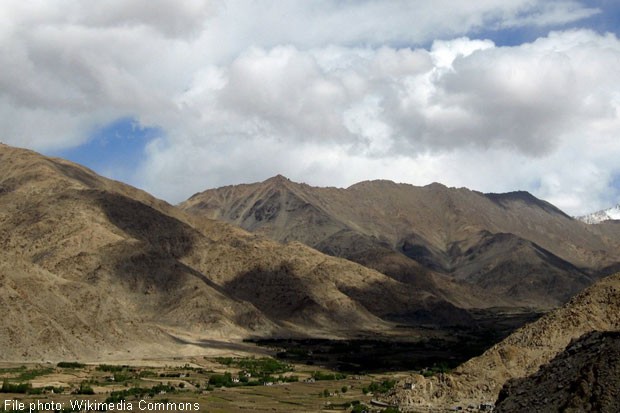Journey 'into the mountains'

INDIA - The best way to take in the unique landscape of Ladakh - arid terrain and snowy peaks - is by trekking through it.
Bounded by the Karakoram mountain ranges in the north and the Great Himalayas in the south, Ladakh is a high-altitude plateau with average altitude above 3,000m and lies in the state of Jammu and Kashmir in India.
According to travel information, it is also a desert as the Himalayas create a rain shadow, denying entry to monsoon clouds. June marks the start of the trekking season in Ladakh, which peaks in July and August.
There are many treks of varying duration and difficulty and visitors are spoilt for choices.
My friend and I decided to do the trek from Spituk to Stok, one of the more popular treks, crossing the mountain pass Stok La at 4,900m.
The trek can be completed in four days and is easily accessible as Spituk is 7km from Leh, the capital of Ladakh.
We started our trek from the village of Zingchen (3,700m), skipping the five hours' walk from the village of Spituk (3,300m).
We entered the Hemis National Park and made our ascent to Rumbak village at 3,900m. The national park is home to the famous snow leopard, blue sheep, Ladakhi urial (goat), Tibetan wolf, marmot and other animals but we didn't manage to spot any.
En route to Rumbak, the mountains looked bare with no vegetation, and after a five-hour walk, the green pasture and stone structures strewn with colourful prayer flags were welcome indication that we had reached our destination.
Homestay in a mud-brick house
Rumbak, which means "into the mountains", is a small village located in a valley surrounded by towering snowcapped peaks. We stayed with a Ladakhi family in their traditional mud-brick house.
As our elderly hostess served us some butter tea, I stole a few glances at the elaborately decorated Tibetan-style kitchen. From the crockery and cutlery displayed, the hostess could easily whip up a feast for 100 people without running out of pots and pans.
In Rumbak, the villagers depend on agriculture and the occasional homestays for their livelihood. Staying in the village gave us a chance to experience living in such a remote location.
We watched our host's daughter milk the cows and the old lady tend to her sheep. Interestingly, Ladakhis use dry composite toilets which are environmentally friendly.
Standing tall
The next day, we hiked up a winding and steep path to reach the base of Stok La at a 4,900m elevation.
From here, the Indus valley, Mount Stok (Stok Kangri) which stands tall at 6,153m and the surrounding mountains come into full view. One cannot help but notice the rocks ablaze with colours and marvel at nature's deft touches.
We descended from the pass and camped at Mancarmo (4,200m) for the night. Our guide-turned-chef cooked a simple dinner of curry with lentils. We missed out on star-gazing, though, as it was too cold.
The last leg of the trek was relatively easy and we arrived at Stok village before noon.
According to the travel guides, Stok, which is located 15 km south of Leh, was the seat of erstwhile rulers of Ladakh.
The Stok Palace museum is worth a visit. It exhibits rare artefacts such as jewellery, currency and weapons of Ladakhi rulers and gives the visitors a glimpse of the life of the Ladakhi royals. The 14th-century Stok monastery, situated above the palace, is interesting to visit too, especially for its ancient paintings.
Visitors who have more time to spare should attempt the popular Markha Valley Trek, which includes Spituk- Stok Trek. Our guide recommended this nine-day trek for those who want to see the varied landscape of Ladakh.
Shooting the rapids
Besides trekking, river rafting is another exciting way to admire the rugged beauty of the mountains.
Water levels remain high from June to late August, which is the best season for fascinating rafting expeditions.
You can choose to do river rafting on Indus River or Zanskar River. There are rafting expeditions of different length and difficulty.
We did a rafting day trip that started from Chilling and ended at Nimu on Zanskar River. Nimu is the confluence point of Indus and Zanskar rivers.
According to our guide, the route from Chilling to Nimu is 23km on land but only 2km in water.
It was an exciting adventure as we worked together with others in the raft to overcome some challenging Grade 3 rapids.
GUIDELINES
Singapore Airlines, Air India and Jet Airways fly directly to New Delhi. From there, Air India, Jet Airways and GoAir have daily flights to Leh.
- Those arriving by air are strongly advised to rest for at least one day to acclimatise to the high altitude.
- Alternatively, you can travel from New Delhi to Manali and subsequently to Leh by jeep during the summer months from June till October. This route would take about two to three days to complete comfortably.
It is easier to share a jeep with other travellers to visit sites near Leh.
- It is not cheap to trek in Ladakh. The cost of doing a 3D/2N trek for two persons, with a guide and a porter included, is approximately 24,000 rupees (S$500), which is approximately $85 a day. The cost of doing a day trip on Zanskar river is approximately $50 per person for a group of three to six people.
- In Ladakh, the trekking season runs from June to October.
- You can sign up for side trips to Pangong Tso and Nubra Valley with the local travel agents.
For more information on Ladakh, visit:
- BCM Touring: www.bcmtouring.com
- India Mike: www.indiamike.com

Get a copy of The Straits Times or go to straitstimes.com for more stories.